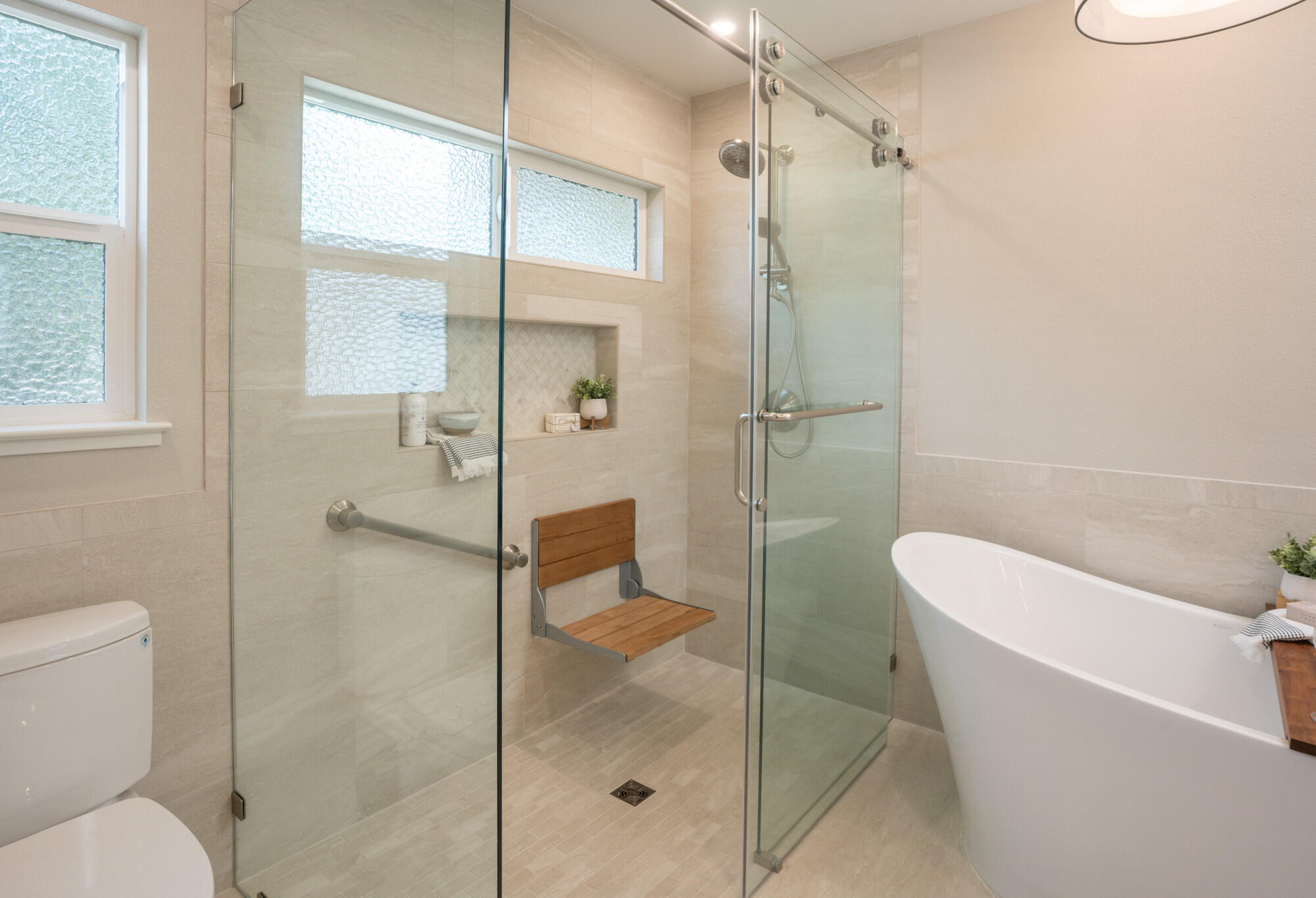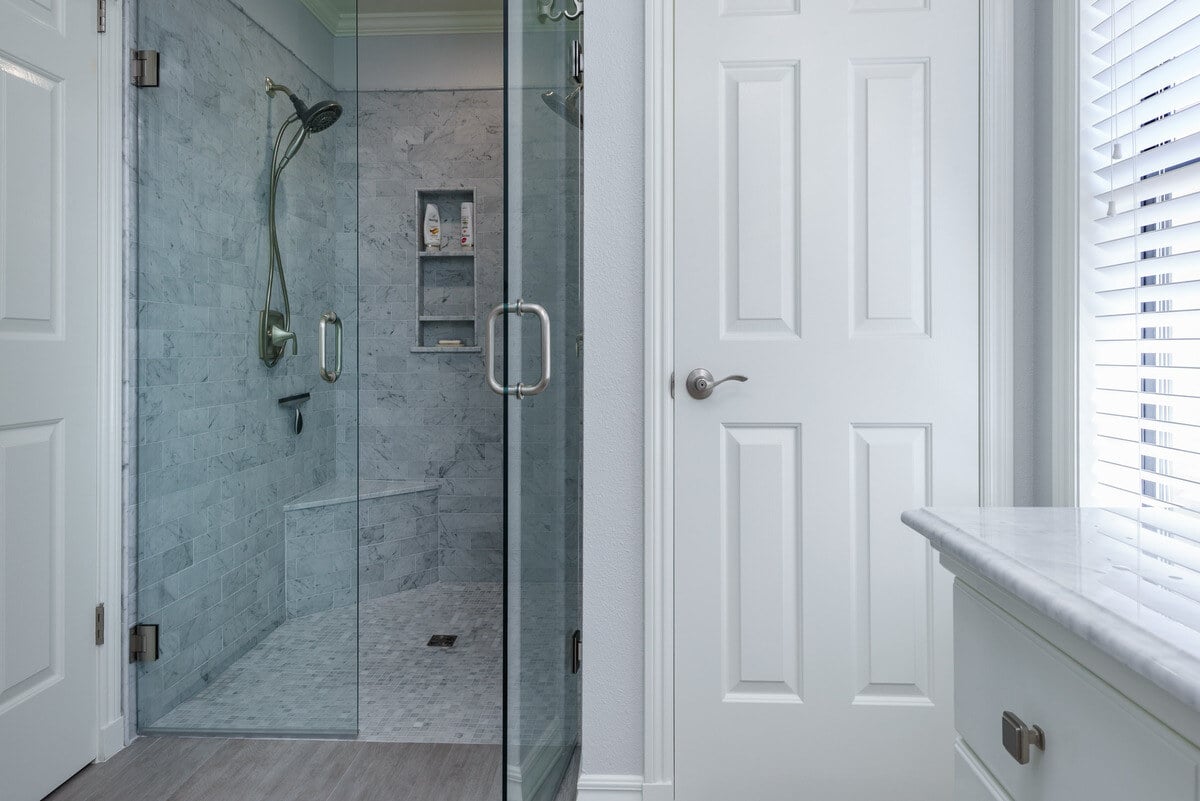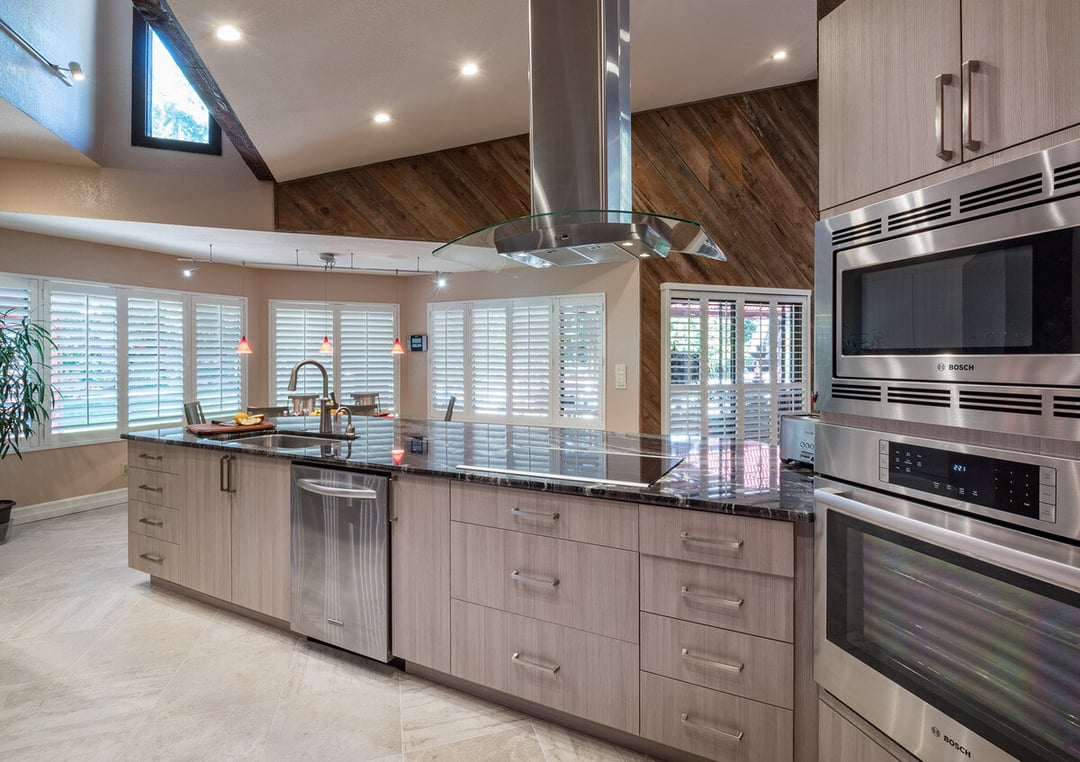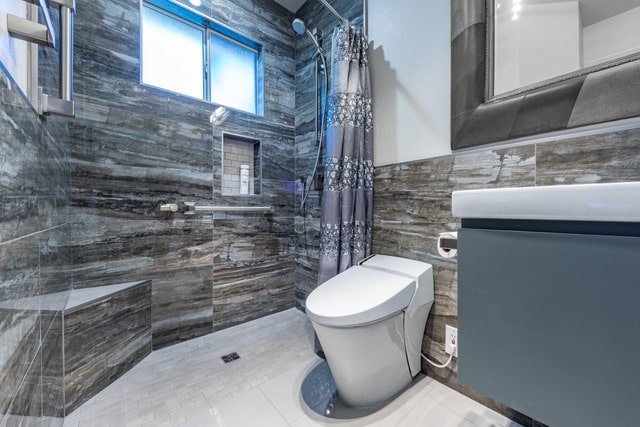

Where will you live when you're 80? Can your current home fit the bill or will navigation issues force a change? Most homes aren’t built with long-term independence in mind. But that's starting to evolve.
Across Fresno and Clovis, more homeowners are looking ahead and updating kitchens, bathrooms, and entryways to support safety, comfort, and mobility as they age. It’s called aging in place, and it’s about making smart, lasting choices so you can stay in the home you love indefinitely.
Whether you're planning for yourself, your parents, or just thinking ahead, Imagine Remodeling of Fresno uses our expert lens to break down the best aging in place home modifications, room by room. We’ll cover practical upgrades, design details, and what to expect when hiring a contractor familiar with universal design.
Where Beauty Meets Accessibility
Here's a great example of creative design and universal function. One of our Fresno clients recently came to us with a clear vision: elevate the design of their kitchen, family room, and hall bathroom without compromising accessibility. Because the client used a high-level wheelchair, we didn’t need to lower counters. Instead, we reworked what was below, replacing base cabinets with smooth-glide drawers and rollout shelves to allow easy, one-handed access.
In the hall bathroom, accessibility was non-negotiable. We prioritized turning radius, shower controls within arm’s reach, and thoughtful fixture placement without losing the clean, modern look they wanted. Every choice balanced safety and style. The result? A space that looks incredible, works seamlessly, and supports independence every day. Here's an in-depth look at how we did it.
What “Aging in Place” Really Means
Aging in place remodeling doesn't have to mean clinical grab bars and hospital vibes. It’s about adapting your space so it works with you as your needs evolve. At its core, it’s about freedom. The freedom to get around your home safely, use the kitchen without strain, and take a shower without worrying about slips or steps. It’s comfort, function, and good design working together.
You’ll also hear the term universal design. While ADA compliance is often about meeting minimum accessibility codes, universal design goes further. It creates homes that are easier for everyone to navigate, whether you’re using a walker, pushing a stroller, or recovering from surgery.
Curious about the local costs of the remodel on your mind? Our updated cost guide is here for you when you're ready to explore.
Key Features of Aging in Place Design
- Step-free entrances and wide doorways for mobility aids
- Lever-style handles instead of knobs
- Non-slip flooring in bathrooms and kitchens
- Clear, consistent lighting throughout
- Smart home features for safety and convenience
Whole-Home Assessment Checklist
Before you start changing fixtures or pricing out tile, take a walk through your home, literally. Look at it through the lens of safety, accessibility, and daily comfort. You’ll start to notice things you’ve lived with for years that might become obstacles later.
Here are a few key areas to check:
- Are your entryways step-free, well-lit, and wide enough for a walker or wheelchair?
- Do you have at least one no-threshold shower with grab bars or a layout that can accommodate them?
- Is flooring even and slip-resistant, with no loose rugs or high transitions?
- Can light switches, thermostats, and outlet controls be reached from a seated position?
- Do cabinet doors, faucets, and hardware operate easily without tight gripping?
- Is there clear, open circulation space in high-use areas like the kitchen and family room?
- Are stairs manageable now, and is there a plan if they’re not down the line?
Safe Interior Circulation
Once inside, the goal is simple: move through your home easily, without tripping hazards, tight corners, or awkward transitions. Aging in place home modifications often start with circulation, making sure that the flow from room to room works for you now and later.
Key upgrades for better mobility and ease:
- Widen interior doorways to at least 36 inches to allow for walkers or wheelchairs.
- Replace door knobs with lever handles that don’t require a strong grip.
- Install non-slip flooring in hallways and high-traffic areas (think vinyl, cork, or textured tile).
- Add senior-friendly lighting in stairwells, halls, and transition zones. Motion sensors are a game-changer.
- Create clear walking paths free from rugs, cords, or furniture that narrows space. Consider contrast edging for extra visibility on stairs or thresholds.

Bathroom Modifications That Matter Long-Term
Bathrooms are where most aging-in-place renovations start, and for good reason. Slippery surfaces, tight layouts, and high thresholds are an accident waiting to happen. But with a few strategic updates, a bathroom can be transformed into one of the safest, most comfortable rooms in the house.
Here’s where to focus first:
- Curbless or barrier-free showers eliminate trip hazards and allow for walk-in or roll-in access.
- Grab bar installation near the toilet and in the shower provides reliable support. When placed correctly, they become second nature.
- Comfort-height toilets reduce strain on the knees and hips.
- Wall-mounted sinks or vanities with open clearance below are ideal for wheelchair access.
- Slip-resistant tile flooring adds safety without sacrificing style.

Kitchen Updates for Ease & Safety
The kitchen is one of the busiest, and most demanding, rooms in any home. For aging in place, it’s also one of the most rewarding to update. A well-designed accessible kitchen remodel reduces strain, increases independence, and makes everyday tasks feel manageable, not exhausting.
Smart kitchen upgrades to consider:
- Pull-down shelving in upper cabinets makes storage reachable from a seated or standing position.
- Roll-out trays and drawers in lower cabinets eliminate the need to crouch or dig.
- Lever-handle faucets or touchless models are easier on hands with arthritis or limited strength.
- Induction cooktops reduce the risk of burns, since they only heat when cookware is in place.
- Rounded countertops and islands help prevent bruises or injuries in tight spaces.
- Lowered counter areas offer optional prep space for those using a stool or chair.
The layout matters, too. Wide, open U-shaped or L-shaped designs provide better maneuverability than traditional galley kitchens. And lighting? Under-cabinet LEDs with rocker switches can make a big difference for aging eyes.
Smart Home Tech for Seniors
Technology is a powerful tool for safety and peace of mind. When thoughtfully integrated, smart home tech for seniors can help support daily routines, emergency alerts, and even social connection.
Here are a few top tech upgrades that align with aging in place design:
- Voice-activated lighting and thermostats (like Alexa or Google Home) reduce the need to reach or bend.
- Smart doorbells with video give homeowners a safer way to screen visitors.
- Motion-sensor lights in halls and bathrooms provide automatic illumination for late-night trips.
- Fall detection sensors can be integrated into wearable devices or room monitors, alerting family or care providers instantly.
- Smart ovens and appliances with auto shutoff functions add an extra layer of safety in the kitchen.
- Remote entry locks let you grant access to caregivers or family without needing to physically open the door.

Choosing a Qualified Contractor
Choosing a contractor with experience in universal design and accessibility is so important. Imagine Remodeling brings all of this to the table, along with a reputation for high-quality work and thoughtful, responsive service.
Here’s what to look for when hiring a senior home renovation specialist:
- Experience with accessible remodeling. Ask to see photos of past projects or case studies involving barrier-free showers, grab bar installs, or open-concept kitchens with pull-down storage.
- Familiarity with local building codes. In Fresno and Clovis, certain updates (like ramp additions or bathroom expansions) may require permits or ADA compliance checks.
- Certified Aging-in-Place Specialist (CAPS). This credential from the NAHB signals that your contractor understands the nuances of accessible design.
- Willingness to collaborate. A good contractor listens first, then builds. They’ll help identify practical changes that align with your lifestyle, not just your layout.
- Fully licensed, bonded, and insured. Always a non-negotiable.
Why Aging in Place Just Makes Sense
Choosing to stay in your home doesn’t mean settling, it means planning ahead with care and confidence. Aging in place updates offer benefits that go far beyond safety alone.
Comfort in Familiar Spaces
You know every light switch, every creaky floorboard, and how the sunlight hits your kitchen in the morning. Staying home means you keep those quiet comforts that make daily life feel grounded.
Greater Independence
Well-designed updates give you more control, not less. From hands-free fixtures to no-step entries, these changes support your routine without needing daily help.
Cost Savings Over Time
Long-term care facilities are expensive. Investing in home modifications now can significantly delay or prevent the need for assisted living, saving tens of thousands of dollars down the line.
Customization to Your Needs
This isn’t one-size-fits-all. Whether you need a curbless shower, pull-down shelving, or wide-open pathways, your remodel is tailored to how you live.
Peace of Mind for You and Your Family
This one is for everyone who cares about you. Aging in place design brings reassurance to kids, caregivers, and loved ones who want to see you thrive at home.

FAQ: Aging in Place Remodeling
How wide should doorways be for aging in place?
We recommend a minimum of 36 inches to accommodate wheelchairs, walkers, or simply give more clearance for everyday movement.
Does Medicare pay for home modifications like grab bars or ramps?
In most cases, Medicare does not cover these upgrades. However, some state and local programs may offer grants or low-interest loans.
What is a curbless shower?
A curbless shower (also called a barrier-free shower) has no step or threshold. The floor slopes gently to the drain, making it safer and easier to enter, especially for those using mobility aids.
Is universal design just for older adults?
Not at all. Universal design benefits everyone, from aging adults and people with disabilities to young children or anyone recovering from injury. These spaces are simple and intuitive to operate.
Do I have to sacrifice design for accessibility?
Absolutely not. In fact, some of the most beautiful spaces we’ve designed are also the most functional. Accessibility and style can (and should) go hand in hand.
Ready for Aging in Place Remodeling in Fresno or Clovis?
Whether you're looking to improve comfort, accessibility, or peace of mind, Imagine Remodeling can help you update your home with purpose. Our design-build remodeling services can easily include aging in place home modifications that blend function and design, so you can stay where you feel most at home. Ready to explore what's possible for your home? Contact us here to get started!

